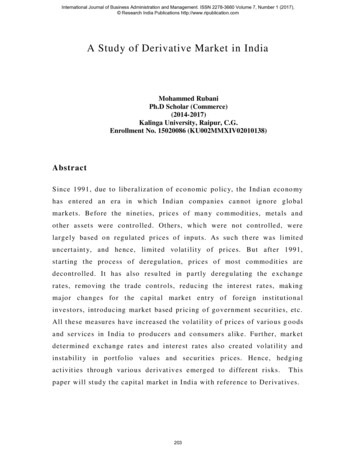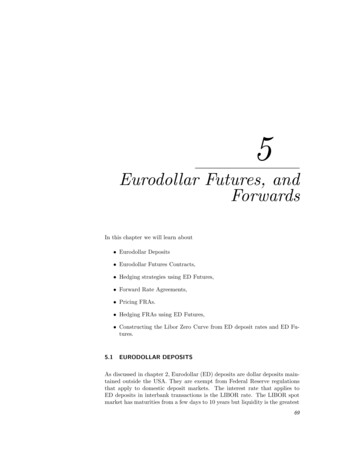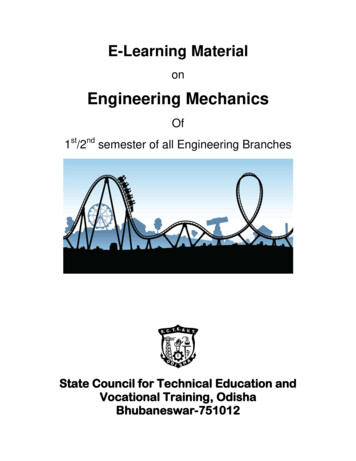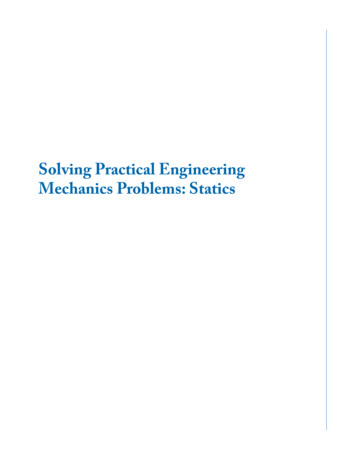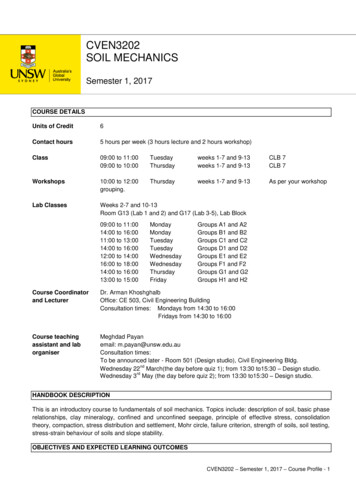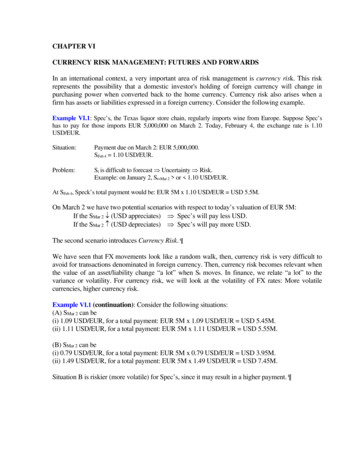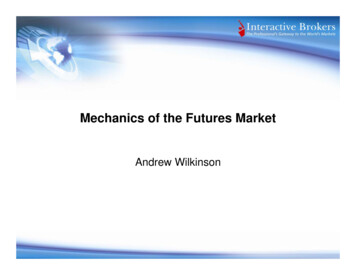
Transcription
Mechanics of the Futures MarketAndrew Wilkinson
Risk DisclosureOptions and Futures are not suitable for all investors. The amount you may lose maybe greater than your initial investment. Before trading options read the“Characteristics and Risks of Standardized Options”. Before trading futures, pleaseread the CFTC Risk Disclosure. For a copy of either disclosure, call (203) 618-5800.Any strategies discussed, including examples using actual securities and price data,are strictly for illustrative and educational purposes only and are not to be construedas an endorsement, recommendation or solicitation to buy or sell securities.Past performance is not a guarantee of future results.Interactive Brokers LLC is a member of NYSE, FINRA, SIPC
Who uses futures or forwards? Speculators – seeking to beat the system Hedgers – seeking to protect a position Futures allow investors to lock into prevailing prices
RiskInvestment risk Market risk Company specific riskFutures markets are exchange traded Provides an actively traded venue where long and short risk can beallayed Mitigates counterparty risk
Underlying products and futures contracts Cash or spot prices exist all year round –But crops only grow once a year The basis represents the difference between spot andthe forward price of a future Future prices can help a farmer determine selection ofnext year’s crop Futures allow market participants around the globe tosee current price of a product not yet produced
Forward prices, Contango & Backwardation Futures contracts allow speedy and efficient entry andexit without ever owning the underlying Investor bears no production costs Contango – when forward prices are higher than spot Expected to decline towards spot price over time Backwardation – when forward prices are lower thanspot Expected to rise towards spot price over time
Where are derivatives traded? Trading typically involve two counterparties Bank-to-bank or bank-to-customer Over-the-Counter Exposes counterparty risk Regulated exchange reduces counterparty risk and Creates transparency
Futures transaction bring focus to investorsand producers Creates contract at a price set today but due at a later date Details of legal contract are standardized Exchange organization draws a global crowd together Producers End-users Speculators Transparent pricing and improved liquidity
Futures contracts have become commoditized All buyers and sellers deal in standardized agreement Exchanges list contract quantity and quality of a contract Example – Nymex Crude Oil contract controls: 1,000 barrels (42,000 gallons)Grade light, sweet as defined by refinersExpiration dates are definedPhysical settlement at predetermined destinations Non-physical instruments are cash-settled by payment atexpiration to reflect the difference between the executionand settlement prices.
Futures trading requires margin Exchange monitors price swings over time This governs size of margin required Margin is a good-faith deposit by investors to helpassure that investors abide by the exchange rules Margin must be held and may increase should the pricemove adversely against investor
Futures options (FOPs) Many futures contracts allow trading in options contractsbased on the same underlying. Futures may serve in many cases as the underlyingbenchmark off of which options are traded and settled The options may be used for: Speculation Hedging Certain options are cash settled; others may be settledinto the futures contract
The role of the exchange Maintains orderly venue for tradeDetermines membershipEnforces good financial standing of membersDevises rulesMonitors liquidity and member participationCreates position limitsGuarantees performance of its members & protects membersagainst failure of others Provides clearing house where trades are processed and marginsare collected
What happens on an exchange? Exchanges are evolving from open outcry to electronic Professional, qualified traders gather in a “pit” wheretrading takes place face-to-face Members may trade for their own account or on behalf ofcustomers Open outcry typically runs parallel with electronic trading Increasing amounts of information are available totraders as depth-of-book shows bid and offers aboveand below prevailing price
What types of futures products can be traded? Grains Corn – Soybeans – Wheat Rice – Soybean Oil – SoybeanMeal Energy Crude Oil – Gasoline – HeatingOil – Natural Gas Financials Interest rates – Currencies –Equity Indices Softs Coffee – Cocoa – Sugar – FrozenConcentrated Orange Juice –Sugar Metals Gold – Silver – Copper – Nickel –Lead – Platinum – Rhodium –Palladium – Tin
Trading on margin Futures trades are undertaken using a margin account Exchange provides a minimum margin that broker mustcharge its client Margin is a good faith deposit required from the investorto guarantee the investment in the event that thecontract price moves against the investor.
Initial margin (per contract) Following an opening tradeinvestor’s cash account hasinitial margin deducted bybroker Often known as a PerformanceBond Cash or a liquid instrumentbacking a trade that mightmove against investor Initial Margin Requirement Gold 4,500 Cocoa 3,750 10-year U.S. Note 2,430Futures margin requirements aredetermined by each exchange and canchange frequently. All marginrequirements are expressed in thecurrency of the traded product.
Maintenance margin Initial Margin Requirement Gold 4,500 Cocoa 3,750 10-year U.S. Note 2,430 Maintenance MarginRequirement Gold 3,333 Cocoa 3,000 10-year U.S. Note 1,800
Daily limits Exchanges may set daily price limits intended to preventdisorderly markets A market may be halted should prices reach limit The limit may coincide with value of maintenance margin Aim is to protect all parties from unwarranted losses intimes of market disorder
What exactly am I buying when I buy a futurescontract? Example – NYBOT Cocoa future Contract for 10 metric tonsContract Code CJCash SettledSettlement months March, May,July September & December See Interactive Brokers website: Trading Contract & Securities Search
Contract search
Contract informationDefines: ExchangeExchange and IB trading symbolPrevious day’s closing priceCategory (softs, energy etc)Last trading dayExpiration date
Minimum tick size and multiplier Multiplier explains the dollar value of a single tick changein the price of the future
eMini S&P future – tick value
eMini S&P future – tick value Buy 1 contract @1012.75 Sell 1 Contract @1017.25 Change in price 4.50 points Times by 50 multiplier 225
Trading example – long future Cocoa Contract Bought one contract March 2010 Nymex cocoa future @ 2,500 Sold one contract March 2010 Nymex cocoa future @ 3,000 Difference 500 Multiplier 10 Dollar Gain 500*10 5,000
Selling futures short (at a loss) Crude Oil contract Sold one contract March 2010 crude oil future @ 72.45 Bought one contract March 2010 crude oil future @79.45 Difference (7.00) Multiplier 1,000 Dollar Gain (7.00)*1000 ( 7,000)
Futures cost of carry Cash market is real time Forward markets areadjusted by “fair value”concept Need to adjust for Dividends Cost of capital Possible arbitrage
Conclusions & Questions Futures are extremely efficient and low cost investmentopportunities Provide hedging and speculation without ever owningthe underlying Ongoing transformation to electronic markets continuesto lower trading costs
Trading on margin Futures trades are undertaken using a margin account Exchange provides a minimum margin that broker must charge its client Margin is a good faith deposit required from the investor to guarantee the investment in the event that the contract price moves against the investor.




